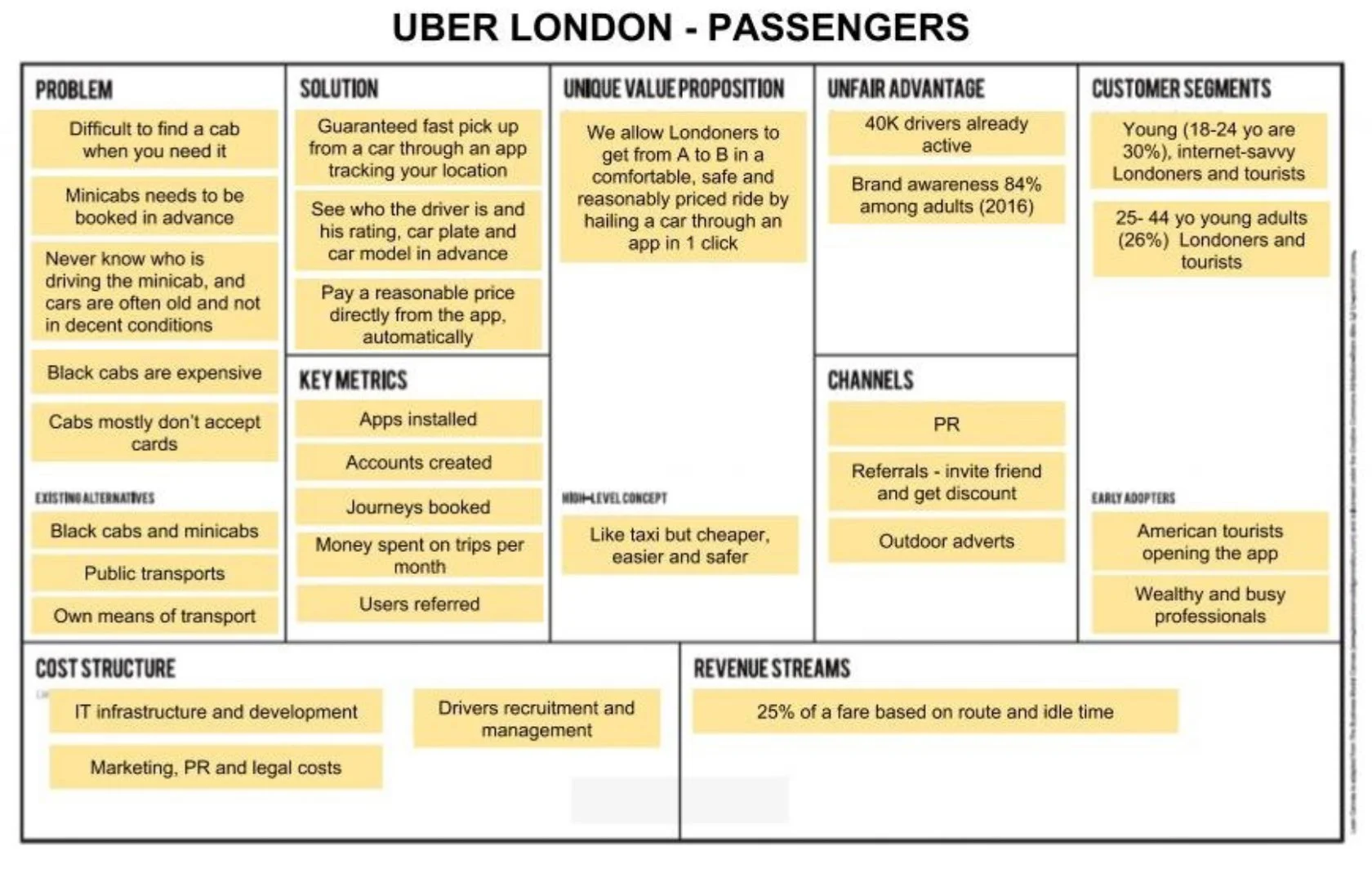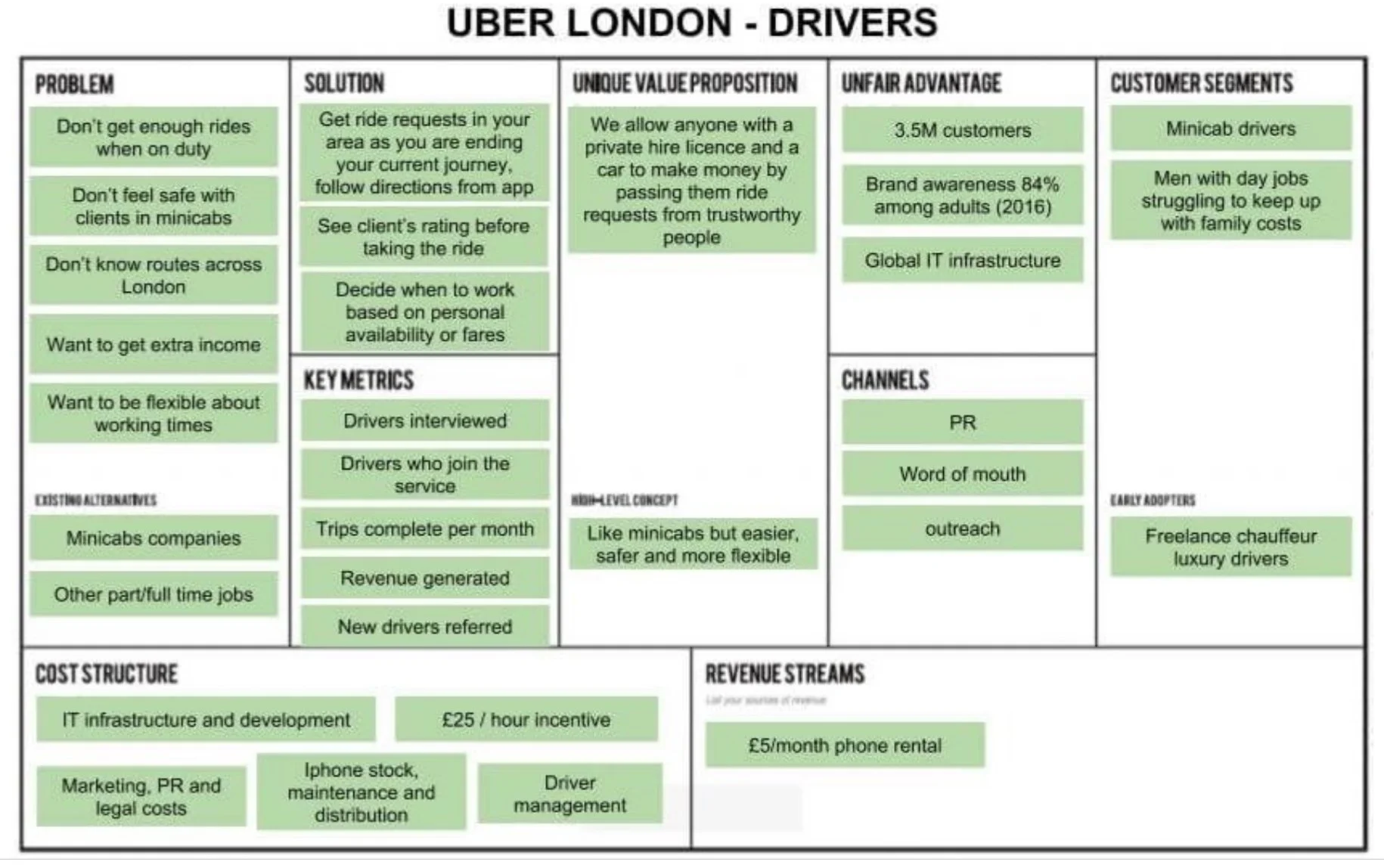How To Compile A Lean Canvas, The Business Plan In One Page
Have a business idea? Take the first step of your Lean entrepreneurship journey by compiling a Lean Canvas.
To compile a Lean Canvas is the first thing to do to evaluate a business idea and to identify the riskiest assumptions to be tested. A Lean Canvas is also the perfect companion along the journey from initial idea to Problem-Solution fit.
It’s extremely useful because the whole concept behind a Lean Canvas is to briefly and concisely explain a business idea to a person who does not know anything about what the company is doing and why. It just takes a few minutes to create the first draft and it’s so powerful that the simple act of preparing it will help anyone with a business idea to get more clarity on their thoughts.
You can download and use our Lean Canvas here. You can either print it, or copy and paste it into a Powerpoint or Google Slides deck to edit it.
Three Key Rules to Compile the Perfect Lean Canvas
Although the Lean Canvas has been designed to be simple and straightforward, it might present some challenges for first-timers. There are three key rules to keep in mind:
– write sentences that are specific and concise. Don’t just write “time” as a problem, but, for example, “the process of finding the right supplier is complex and requires too much time” . Keep sentences simple, straight to the point, short (maximum 10 words each) and meaningful. Make full use of verbs and adjectives.
– after you have prepared a draft, go through each step, telling this story to yourself: we will help these people (customer segments) to solve (problem) by providing them (solution). They will know about us through (channels) and they will be convinced to join us because (value proposition) and because we already (unfair advantage). We will charge them by (revenue) and we believe this will cover our (costs). We will measure our performance by tracking (key metrics). It should all flow and make sense like it is a story where everything is linked. If it doesn’t, the Lean Canvas needs more work.
– prepare a Lean Canvas for each customer segment of your business idea. This is because each customer segment may have different problems, solutions, channels, revenue, costs, etc. So if you are considering a business idea that is a marketplace, compile one Lean Canvas for the demand side, and one for the supply side. Each of them will have different problems, and so your solution will change accordingly
For the same reason, if you are considering a business idea where user do not pay for the service they use (e.g. advertising funded businesses), compile a Lean Canvas for the users and one for the customers who pay for the service/product.
A Lean Canvas Example: Uber London
To get an idea of what we are talking about, let’s see an example of how a Lean Canvas would look like for a well-known company: Uber in London.
With Uber being a marketplace, its job is to let demand (passengers) and supply (drivers) meet.
We have then two different customer segments, passengers and drivers, and so two different canvases need to be compiled.
This is the first one, for Uber passengers.
A simplified version of Uber London’s Lean Canvas for Passengers
And this is the second, for Uber drivers.
You can see how the sentences are concise and to the point, and the entire canvas seems to flow when you read it starting from the customer segment like it’s all linked.
Let’s go through the story the Lean Canvas for Uber passengers is telling:
Uber helps young internet savvy and young adults Londoners and tourists (customer segments) to make it less difficult to get a cab instantly, to feel less concerned about safety and car conditions and not to pay a high fare through cash (problems) by providing them an app that tracks their location and guarantees a fast pick up, shows the driver’s name, rating, car plate and car model in advance and allows them to pay a reasonable price directly and automatically from the app (solution). They will know about Uber through PR, referrals and outdoor adverts (channels) and they will be convinced to join us because we allow Londoners to get from A to B in the comfortable, safe and reasonably priced ride by hailing a car through an app in 1 click (value proposition) and because we already have 40k drivers in London and a 84% brand awareness among adults (unfair advantage). We will charge them by cashing in 75% of a fare based on route and idle time (revenue) and we believe this will cover our IT infrastructure development, marketing, PR, legal and drivers recruitment/management costs (costs). We will measure our performance by tracking how many customers install our app, how many create an account, how many journeys they book, how much revenue per month they generate and how many friends they invite to join (key metrics).
This is how it should be.
Moreover, you might have noticed that most of the elements of the two canvases are different. This is because each customer segment of the marketplace is different, and so are their problems, the solutions that Uber is offering to them, the value proposition and the channels that they use to acquire them, etc. To put it simply, drivers want to make money flexibly and independently by driving a car, while passengers want an easy way to get a cab that is cheap and safe. How could they be in the same Lean Canvas?
This is super important, so in case it’s not clear enough, we suggest reviewing the two examples again before proceeding further.
Step By Step Guide to Compile a Lean Canvas
Now that we have a clear idea in mind of what a good Lean Canvas looks like, let’s see step by step how to compile a meaningful one, using the Uber passenger Lean Canvas as an example.
The steps are in sequential order because whatever is coming first is building up for the next. So make sure to follow the process.
Problem
Which problems are you willing to solve with your business idea?
Your business idea is worth nothing if it’s not solving someone’s problems. So let’s start from here. In this section, you should write a brief description of at least the top three problems you are going to solve with your business idea, the strongest frustrations or aspirations that your potential customers have.
The best way to describe the problems is in terms of the jobs customers need to do, what they are ultimately trying to achieve and what is the pain or the frustration they currently feel. Possibly with a concise sentence.
Please make sure that you write problems in a way that anyone completely unaware of what the business is about is being able to understand. So avoid technical terms or single words like “time“, or “price“, as these will be very hard to understand for external people and are not really explaining what is the frustration.
In the example any Uber user – especially in London – can easily relate to the problems listed. You can see they are mostly related to three main areas: it’s a struggle to get a cab, there are safety and trust concerns and then cost/convenience to pay.
Please also see how they have been described with short and specific sentences, no more than 17 words in length and very much to the point.
The most important thing here is that problems needs to read like a problem. So for example, writing “find a cab” does not read like a problem and writing it in this way is not going to help. Try “It’s difficult to find a cab when you need it” instead.
Existing Alternatives
How can these problems be solved today?
These are the current competitors in your future business. Customers may be solving the problems through a single service, or through a combination of them, or even through basic and primitive techniques, and for some reasons, all these services are failing them. By listing competitors, you will be able to compile a competitive analysis and differentiate your value proposition later in the process.
The interesting thing about writing down competitors is that you have another angle to look at the customer problems. How are existing alternative failing them? Use this analysis to write down additional problems above.
Customer Segments
Now that we know which are the problems that you are willing to solve with your business idea, let’s focus on who is actually having these pains. This is crucial, as customers are at the center of any new business or new product development that actually works.
Who do you think is suffering because of the problems you are going to solve?
– Do these people have specific job titles or roles?
– Do they work in specific industries?
– Do they have particular demographics/salary range?
In case of a marketplace or multi-sided platforms, you will need to create two lean canvasses, one for the supply, another for the demand.
The same applies in case you are undecided on which customer segment is most attractive for your business; you will have to compile a lean canvas for each one.
The segments listed in the example are the majority of Uber users in the City.
An important point here is that Customers needs to have the problems TODAY. Not in an hypothetical future, where perhaps you will educate customers about a problem they don’t currently have. That’s not going to work.
Early Adopters
Who do you think feels those problems the most?
Do they have specific job titles or roles? Are they working for specific companies/sectors?
This is about who feels the problems the most and is inefficiently already trying to solve them in a way that you believe you can solve better through technology.
Identifying early adopters is extremely important because these are the ones that are going to be your first customers and the first version of the business is going to be crafted around them.
Moreover, since they are more in need than others of something solving their problems, they will forgive imperfections or flaws of the early releases. Identifying and conquering the early adopter’s segment is the most important thing to do when launching a new business. You can recognise them among all other customer segments because they have four features. Find out more about what are these features and how to identify early adopters.
In Uber example, they famously started in London targeting the high end of the market and by providing a service that, back in 2012, was “everyone’s private driver” offering luxury car trips to professionals with a salary much above the average.
Solution
What are you going to do to solve customers problems?
Here you should describe your business idea not in a technical way, but with brief and concise sentences that explain what the customer experience is going to be.
Each problem should be matched by a solution.
So for example, looking at Uber:
It’s difficult to find a cab when you need it and minicabs need to be booked in advance -> the solution is a guaranteed pick up from a car through an app tracking your location
You never know who is driving the minicab, and cars are often old and not in decent conditions -> the solution is that you can see who the driver is and his rating, the license plate and the car model in advance from the app
Black cabs are expensive and they mostly don’t accept cards -> the solution is that you pay a reasonable price directly from the app, automatically.
As you can see, it’s very clear what we are talking about: it’s a mobile app that allows people to book a cab, see who the driver is in advance and pay a fairly priced trip automatically. You mum would understand it.
Unique Value Proposition
How would you describe your business to target customers in one just ONE sentence?
A Unique Value Proposition is a sentence that tells why what you do is different from competitors and why that difference matters to customers. It describes the unique way your are going to provide value to your customers.
Writing a good value proposition is not easy, it might take years of experience to learn how to craft a powerful and meaningful one. It usually combines:
– the target segment
– the key problem
– the key benefit your customers are going to get after having used the service/product
– the special and unique way you will deliver it
All in a single statement, possibly less than 200 characters long.
A good template that we often use is “We help (who?) achieve (what benefit?) by doing (the special and unique way the new business/new product is doing it)”.
In the Uber example, it sounds like: we allow (who?) Londoners to (what benefit?) get from A to B in comfortable, safe and reasonably priced ride by (the unique way the business is doing it) hailing a car through an app in 1 click.
High-Level Concept
How would you briefly describe what you do when you meet someone at a networking event?
The high-level concept is a single and very short statement that describes your business idea. For example YouTube = Flickr for videos.
This is the so-called “elevator pitch”, and it’s important because you will use it everywhere: when explaining what you do at events, when the press wants to communicate what you do, etc. Your future team members, investors, recruiters and customers will use it when talking about your company as well.
If it is too long it means that you don’t have enough focus yet, and you will need to work until it feels right, concise and catchy.
Channels
How are you going to acquire your customers?
Once you have a product designed to solve customers problems in a unique way, how are customers going to know about that?
Are you going to use Social media? Paid Online advertising? Google adWords? PR? Cold calls? Partnerships?
Most successful startups have 2 or 3 marketing channels that work best for them. The effort at this stage is to list all possible channels so that you can later validate whether they can really make the difference or not.
Unfair Advantage
What makes you special?
This a tricky one, the unfair advantage is NOT the competitive advantage that you believe you will have once you have launched the business. Instead, it has to be something that you already have, and cannot be copied or bought, and would require a considerable amount of time for anyone else to build.
An unfair advantage makes you different from anyone else willing to launch the same exact business. Ask yourself: why do I believe to have more chances to be successful than anyone else?
For example, it might be a long time experience in the industry, credibility in a particular area or skill, access to a broad network of industry contacts, having filed patents or owning IP, having launched a similar business in the past, having access to a strong community or list of potential customers, being part of a prestigious University, having won awards, being part of the cohort of an incubator… All these things will make your life much easier, but also may support you to acquire customers!
In the Uber London example, today they would be more successful than anyone else willing to do the same because they already have 40k drivers working for them. Moreover, Uber has incredible brand awareness.
As you can see from the example, you’ve got to be specific here. How many years of experience in the industry do you already have? Which industry exactly and which role? If you can leverage an existing community, how many active members there are?
It’s ok if it’s empty.
Revenue
How will you charge your customers for solving their problems?
Is the new business going to be a freemium service, a free service funded by advertising, are customers going to pay a one-off fee to use it or are they going to subscribe?
Try to list here the top three ways you will charge your customers. It’s ok not to put numbers at a very early stage, just how you are planning to charge them or get money from your product.
Costs
What are the expected costs to run your business?
There is no need to write down the numbers at a very initial stage.
But at least you should list the ones you can think of.
At the end of the business idea validation process you will have clarity about these two last steps, and you will be able to calculate how many paying customers you will need to cover the fixed costs.
Key Metrics
How are you going to measure your business performance?
A good framework is a funnel called AARRR: Acquisition, Activation, Retention, Revenue, Referral.
Which are the customers’ actions that you are going to track to define the steps above and monitor your business performance?
In the Uber example: Passengers download the app first (Acquisition), then they may create an account (Activation), they may book a few journeys (Retention), they would generate revenue for the business by paying for those journeys (Revenue) and finally they may send a referral code to their friends to invite them to join (Referral).
More Lean Canvas examples from Amazon, Airbnb, Facebook, Youtube and Google are available here.
Main sources for the Uber Lean canvases:
– Uber’s first pitch deck
– YouGov for brand awareness
– The Telegraph for profiles of drivers and passengers in London
– The Guardian for early adopters of the service in London
– Countless late-night chats with Uber drivers



